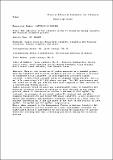Por favor, use este identificador para citar o enlazar a este item:
http://hdl.handle.net/10261/264287COMPARTIR / EXPORTAR:
 SHARE SHARE
 CORE
BASE CORE
BASE
|
|
| Visualizar otros formatos: MARC | Dublin Core | RDF | ORE | MODS | METS | DIDL | DATACITE | |

| Título: | The influence of the catalyst on the CO formation during catalytic wet peroxide oxidation process |
Autor: | Carbajo, J.; Quintanilla, Asunción; García-Costa, A.L.; González Julián, Jesús CSIC ORCID; Belmonte, Manuel CSIC ORCID ; Miranzo López, Pilar CSIC ORCID; Osendi, María Isabel CSIC ORCID ; Casas, José A. | Palabras clave: | Carbon monoxide Metal-free catalyst Catalytic wet peroxide oxidation Fenton Graphene MAX phase |
Fecha de publicación: | 16-dic-2019 | Editor: | Elsevier BV | Citación: | Catalysis Today 361: 30- 36 (2021) | Resumen: | [EN] Herein, the formation of carbon monoxide as a harmful product upon the Catalytic Wet Peroxide Oxidation process is studied in presence of different solid catalysts: an iron supported activated carbon catalyst, a metal-free catalyst based on Graphene Nanoplatelets, and 1.6 wt.% Fe containing CrAlC MAX phase catalyst. The CWPO performance and the evolution of the gas effluent have been compared to that obtained in a conventional Fenton process. Carbon monoxide yield released was significantly lower in Catalytic Wet Peroxide Oxidation process in relation to that obtained in the Fenton process, where CO concentration reaches a maximum of 6651 mg/Nm. By contrast, in presence of activated carbon-Fe catalyst and, notably, Graphene Nanoplatelets and CrAlC MAX phase catalysts, a more progressive phenol and aromatics intermediates oxidation resulted in a much lower CO maximum concentration in the gas phase at the exit of the reactor of 2454 mg/Nm, 170 mg/Nm and 187 mg/Nm, respectively. Hence, when compared to the homogeneous Fenton oxidation, Catalytic Wet Peroxide Oxidation process results be a more sustainable treatment for high-loaded phenolic wastewaters by decreasing the hazardous CO gaseous emissions avoiding this way a secondary pollution during the oxidation process. | Versión del editor: | http://dx.doi.org/10.1016/j.cattod.2019.12.020 | URI: | http://hdl.handle.net/10261/264287 | DOI: | 10.1016/j.cattod.2019.12.020 | Identificadores: | doi: 10.1016/j.cattod.2019.12.020 issn: 0920-5861 |
| Aparece en las colecciones: | (ICV) Artículos |
Ficheros en este ítem:
| Fichero | Descripción | Tamaño | Formato | |
|---|---|---|---|---|
| Carbajo_influence_CATTOD-D-19-00564R1_2019_VS_postprint.pdf | 1,8 MB | Adobe PDF |  Visualizar/Abrir |
CORE Recommender
SCOPUSTM
Citations
9
checked on 22-abr-2024
WEB OF SCIENCETM
Citations
6
checked on 22-feb-2024
Page view(s)
35
checked on 27-abr-2024
Download(s)
55
checked on 27-abr-2024
Google ScholarTM
Check
Altmetric
Altmetric
Este item está licenciado bajo una Licencia Creative Commons

